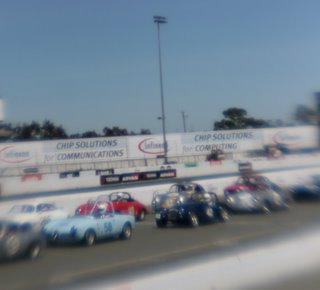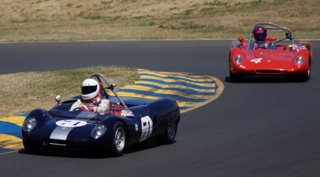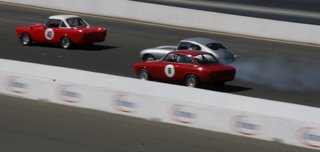OK people -- tired of Koyannisqatsi? Add this one to your list of mind-blowers: documentarian par excellence Errol Morris' 1997 masterpiece, Fast, Cheap, and Out of Control.
It's about four people: a topiary gardener, a lion tamer, a specialist in naked mole rats, and an MIT robot scientist. It sets two of the characters against the others, in a way...on one side you have mechanation, trans-humanism, and insect social structure, and on the other you have the total control of nature and animal instinct. It's totally brilliant and makes you think more than once about, well, everything. I don't want to spoil too much, but pay attention when they start talking about feces. It'll make you squirm for sure.
All this makes me think about what I love about car racing, especially vintage car racing. Actually, I don't care much for modern car races, but with the old cars, I'm totally mesmerized. It's because it catches the entire evolution of automotive development: they start off with these pre-war cars with like 25 horsepower and end up with 1960s V8 monsters, and all the while they balance the power and handling...and it's all a pointless pursuit, more or less. We would have all been better served if they'd built a train system that goes everywhere. But there's something caught up in the intersection of the technical struggle and the beauty of the sheetmetal designs that, I would argue, embodies the best aspects of humans as a species. We have an enormous capacity to create diverse forms of beauty. This is obvious. What isn't so obvious is the relationship between beauty and pointlessness. I seems like it's at its peak when the entire exercise is utterly pointless, like wild animal shows: They're dumb: downright stupid, but there's a certain awe about them that's impossible to deny. But it's almost the as great when an everyday task or need is transformed by an invention: I would argue that as a society, we "Americans" are totally in awe of the automobile. Look at all the people that commut in pickups with giant v8's, or new sportscars, and tell me that this is the product of a rational mind.
Anyway that's all for now. Throw that one on the queue, and if you can stomach another documentary, put Morris' late-1970s masterpiece Gates of Heaven on there as well. Two words: pet cemeteries. Pet cemeteries that I've seen with my two eyes -- and Brett has recently written about.
In which I shill for odd objects, some of which you might actually need. But probably not.
Friday, June 23, 2006
Wednesday, June 14, 2006
Vintage Race 2006

I know that you have been waiting patiently for an update, gentle readers. And I think that I do have something that might interest you.
Our story begins last year, June 5th, 2005 -- Brett's birthday weekend, and I've already messed up by not getting her a cake. Oops, who knew it was such a big deal? My plan for recovery, you ask? Why not take her to the Jaguar Vintage Car Classic at the Infineon? I mean, what girl doesn't like that?
Oddly enough, she consented. And odder still, once we got there, she loved it.
Really! She loved it. Both of us got teary-eyed, sitting there in the sun watching an amazing array of old racing and sports cars, not in a museum, but cranking around a racetrack, screaming their hearts out. And she hasn't stopped talking about it since.
This year, we brought the camera and she, Brett Ascarelli, my fabulous in-house photographer, snapped some shots. Here are a few favorites:
These cars are so damn small!

Check out the smoking E-type -- it had to retire after about two laps. Too bad -- that was the mid-late 1960s production sports cars race, and it's fun to see the E-types in a race dominated by Shelbys and Corvettes.

Next up is the "Piranha," a crazy kit car that's based on a Corvair!!! Unsafe at any speed!

But here's my personal favorite: unbelievably, there were a couple of SAABs on the track that day, Sonnett V4's, which were actually raced! About 2,000 Sonnett V4's were produced, a fiberglass-bodied two-seat sportscar. And I totally love them. They were powered by a ford v-4 good for about 65 hp, SAE. Probably like 50 by today's measurements. But they were out there, and they're beauties.

Subscribe to:
Posts (Atom)